- Home
- Articles
- Architectural Portfolio
- Architectral Presentation
- Inspirational Stories
- Architecture News
- Visualization
- BIM Industry
- Facade Design
- Parametric Design
- Career
- Landscape Architecture
- Construction
- Artificial Intelligence
- Sketching
- Design Softwares
- Diagrams
- Writing
- Architectural Tips
- Sustainability
- Courses
- Concept
- Technology
- History & Heritage
- Future of Architecture
- Guides & How-To
- Art & Culture
- Projects
- Interior Design
- Competitions
- Jobs
- Store
- Tools
- More
- Home
- Articles
- Architectural Portfolio
- Architectral Presentation
- Inspirational Stories
- Architecture News
- Visualization
- BIM Industry
- Facade Design
- Parametric Design
- Career
- Landscape Architecture
- Construction
- Artificial Intelligence
- Sketching
- Design Softwares
- Diagrams
- Writing
- Architectural Tips
- Sustainability
- Courses
- Concept
- Technology
- History & Heritage
- Future of Architecture
- Guides & How-To
- Art & Culture
- Projects
- Interior Design
- Competitions
- Jobs
- Store
- Tools
- More
Enhancing Building Acoustics in Interior Spaces for Comfort and Productivity
Explore the vital role of building acoustics in enhancing comfort and productivity within interior spaces. This article delves into fundamental acoustic principles, practical strategies for sound quality improvement, and the importance of designing tranquil environments.
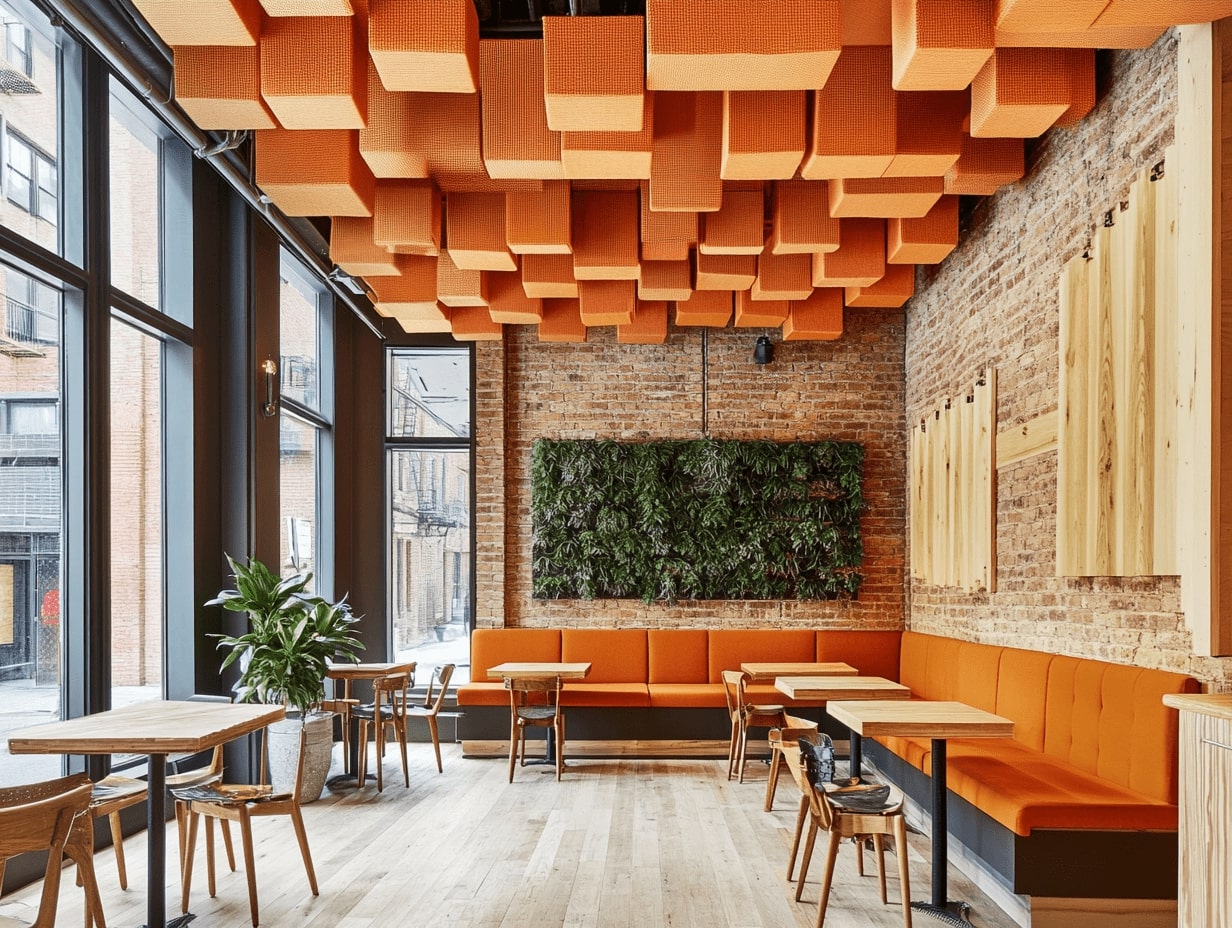
When we think about interior spaces, we often focus on aesthetics and functionality, but what about sound? Building acoustics play a crucial role in how we experience a space. Whether it’s a bustling office, a cozy restaurant, or a serene home, the way sound travels and interacts with surfaces can significantly impact our comfort and productivity.
Understanding building acoustics isn’t just for architects or engineers; it’s essential for anyone looking to create an inviting atmosphere. By optimizing sound quality, we can enhance communication, reduce noise pollution, and foster a sense of well-being. In this article, we’ll explore the fundamentals of building acoustics, practical strategies for improvement, and how we can transform our interior environments into havens of tranquility and focus.

Table of Contents
ToggleUnderstanding Building Acoustics in Interior Spaces
Building acoustics play a crucial role in the functionality and overall experience of interior spaces. By grasping fundamental acoustic concepts, we can create environments that promote comfort, productivity, and tranquility.

Importance of Acoustics in Design
Acoustics influence how individuals perceive sound in interior spaces. Effective acoustic design enhances speech intelligibility, reduces noise distractions, and improves overall sound quality. Spaces like offices, schools, and healthcare facilities benefit significantly from optimized acoustics, leading to increased concentration, satisfaction, and even health outcomes. Prioritizing acoustics in design reflects our commitment to user experience and well-being.
Key Acoustic Principles
- Sound Absorption: Sound-absorbing materials, like carpets and acoustic panels, minimize reflections and echoes, allowing for clearer communication.
- Sound Insulation: Barriers, such as walls and floors, reduce the transmission of sound between spaces. We use materials with high STC (Sound Transmission Class) ratings for effective insulation.
- Room Acoustics: Room shape, size, and surface materials affect how sound travels within a space. An ideal balance of surfaces promotes even sound distribution.
- Background Noise: Managing background noise levels improves sound clarity. We accomplish this through strategic placement of noise-generating equipment and sound-masking systems.
- Reverberation Time: Controlling how long sound persists in a space shapes auditory perception. We aim for optimal reverberation times based on the function of each room.
- Pro tip: In regions with diverse building types and noise challenges, such as Manchester, insights from an acoustic consultants can be valuable for selecting the right combination of soundproofing and absorption techniques suited to local conditions.
By applying these key acoustic principles, we create harmonious and inviting interior environments.
Factors Affecting Acoustics
Acoustics in interior spaces rely on several key factors. Understanding these elements enables us to optimize sound quality and create a more pleasant environment.
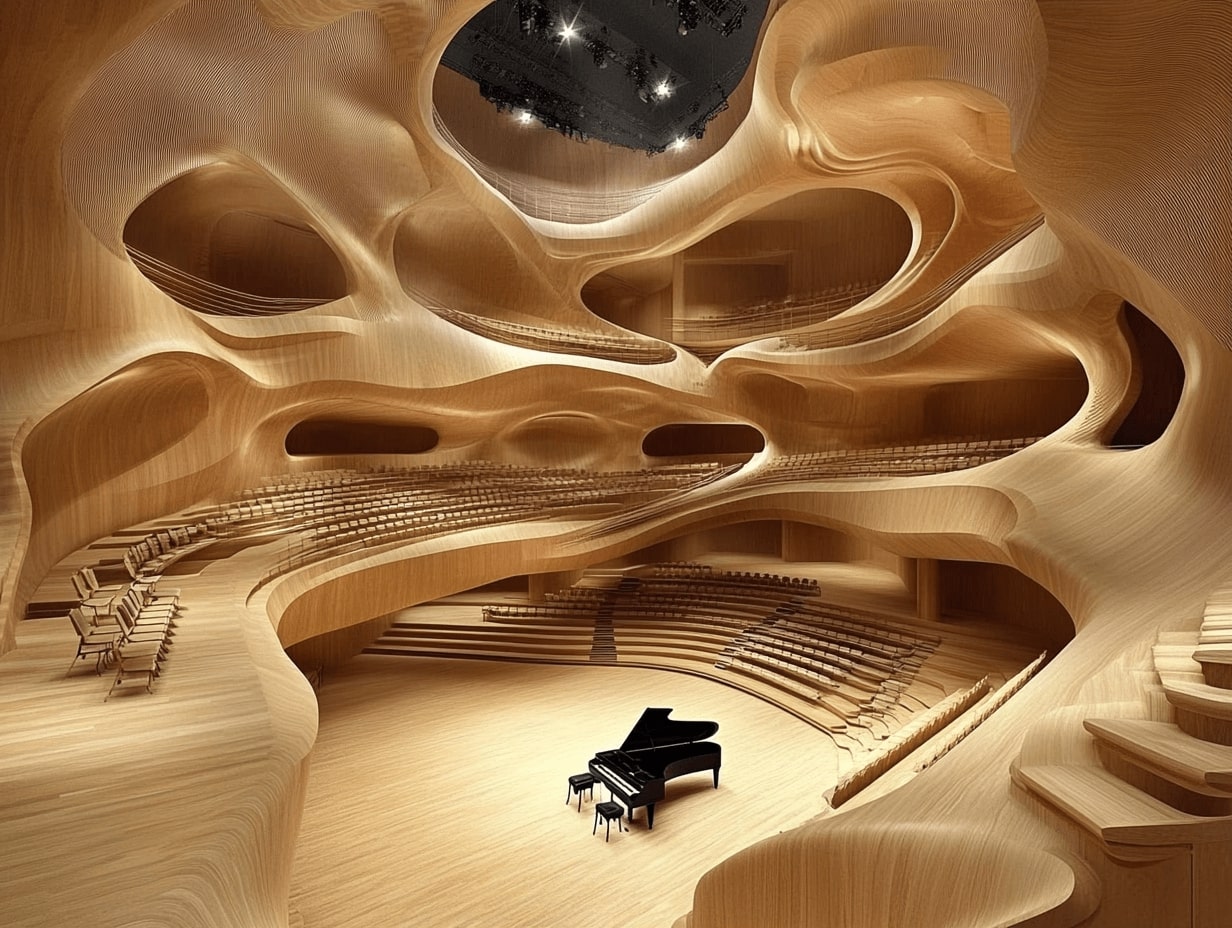
Building Materials
Building materials significantly influence acoustics in interior spaces. We focus on materials’ density, texture, and absorptive properties.
- Dense Materials: Materials like concrete and brick possess high mass, effectively blocking sound transmission between rooms.
- Soft Surfaces: Fabrics, carpets, and acoustic panels absorb sound waves, minimizing echoes and reverberation.
- Composite Materials: Using a mix of dense and absorptive components enhances overall sound insulation and absorption.
Selecting appropriate materials plays a crucial role in achieving desired acoustic properties.
Room Geometry
Room geometry affects how sound waves travel and interact within a space. A well-considered layout optimizes acoustic performance.
- Ceiling Height: High ceilings allow sound to disperse, reducing echoes compared to lower ceilings that may trap sound.
- Room Shape: Rectangular rooms often create sound reflections, while irregular shapes can help scatter sound and enhance clarity.
- Surface Angles: Angled surfaces can redirect sound waves, reducing harmful reflections and improving overall sound distribution.
By analyzing room geometry, we can design interiors that foster effective acoustics and enhance user experience.
Acoustic Treatment Strategies
We implement various acoustic treatment strategies to enhance sound quality in interior spaces. Effective soundproofing and absorption techniques play crucial roles in achieving desired acoustic outcomes. To achieve effective sound absorption and optimize acoustic comfort, choosing the right acoustic products such as high-quality acoustic panels, ceiling tiles, and soundproofing materials is essential.
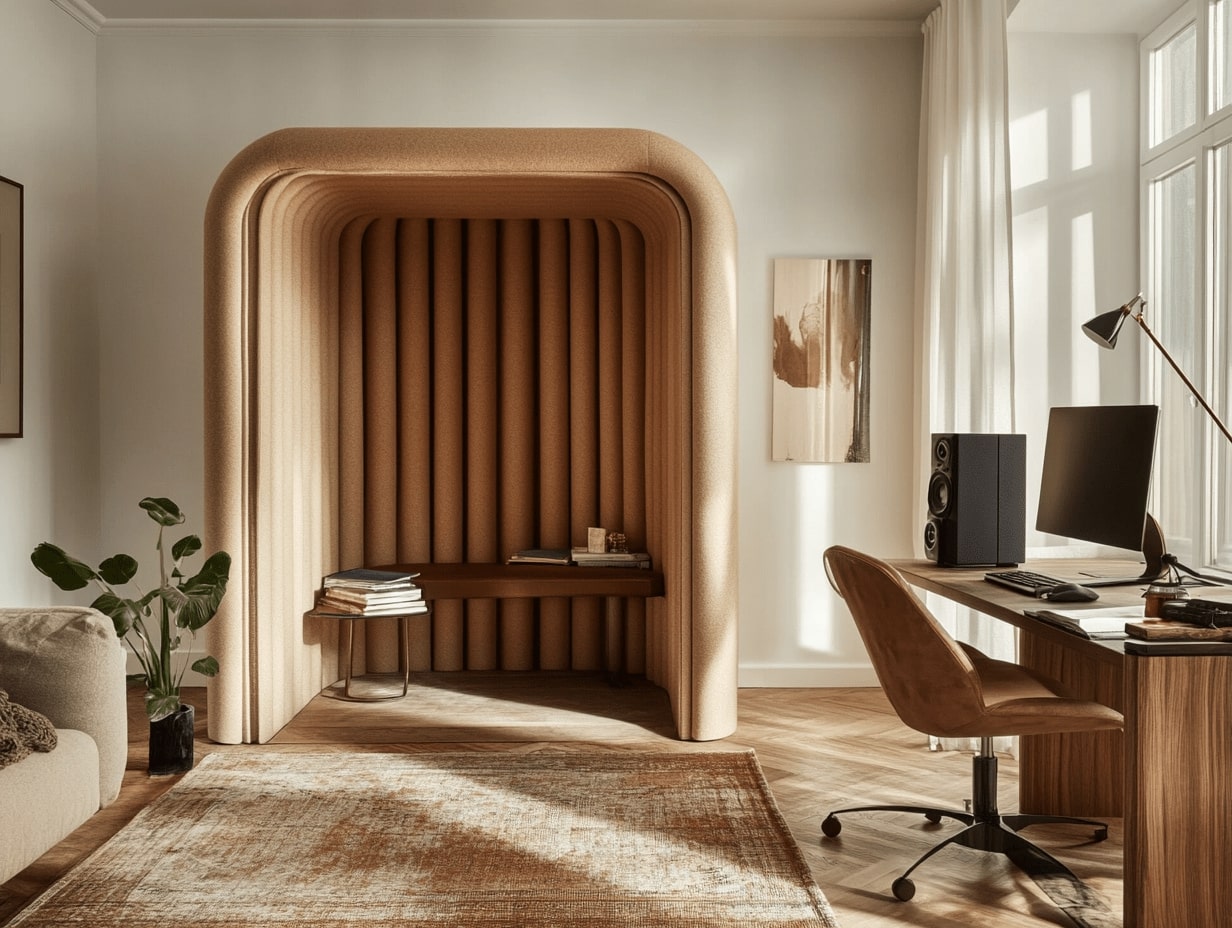
Soundproofing Techniques
We utilize soundproofing techniques to minimize sound transmission between rooms and from external sources. Common methods include:
- Mass-loaded barriers: We incorporate dense materials, like lead or specialized vinyl, to block sound waves. These barriers are often applied to walls, ceilings, and floors.
- Decoupling systems: We create separation between building elements, such as using resilient channels or sound isolation clips. This method disrupts sound transmission pathways.
- Sealing gaps: We seal all gaps and cracks with acoustic caulk or weather stripping to eliminate sound leaks. Proper sealing enhances overall sound insulation.
Sound Absorption Solutions
We adopt sound absorption solutions to reduce echo and reverberation within spaces. Key strategies involve:
- Acoustic panels: We install fabric-wrapped panels, strategically positioned on walls, to absorb sound waves. These panels come in various sizes and colors to suit design aesthetics.
- Soft furnishings: We utilize carpets, curtains, and upholstered furniture to absorb sound. These materials help reduce noise levels while enhancing comfort.
- Ceiling treatments: We incorporate acoustic ceiling tiles, designed to absorb sound, thereby improving room acoustics. Opting for varied textures can enhance absorption performance.
By applying these soundproofing and absorption strategies, we create interiors that offer superior acoustic quality, promoting comfort and productivity in our environments.
Applications of Building Acoustics
Building acoustics apply to various types of interior spaces, affecting comfort and functionality. We can leverage acoustic principles to create inviting and efficient environments in both residential and commercial settings.
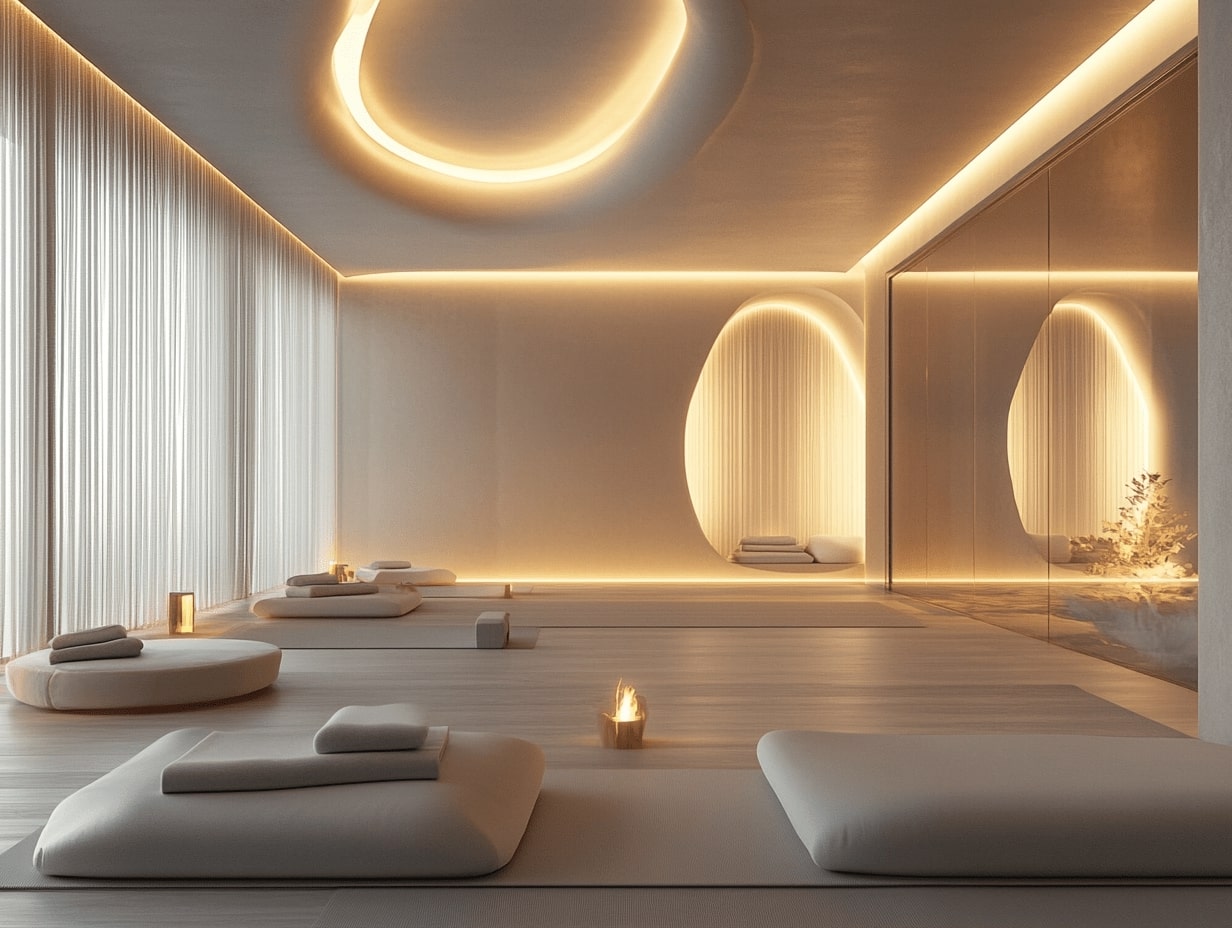
Residential Spaces
In residential spaces, effective building acoustics enhance our quality of life. We can employ soundproofing measures to reduce noise from external sources, ensuring a peaceful living environment. Arranging furniture strategically, using soft furnishings, and installing carpets or rugs improve sound absorption, minimizing echoes and distractions. We’ll benefit from acoustic insulation in walls and floors to enhance privacy between rooms, fostering tranquil atmospheres in bedrooms, living areas, and home offices. Implementing these strategies creates homes that are not only comfortable but also conducive to relaxation and focus.
Commercial Environments
In commercial environments, building acoustics play a critical role in productivity and collaboration. We must consider sound insulation in office layouts to reduce noise spillover between workstations, aiding concentration. Utilizing acoustic panels, ceiling treatments, and partitioning enhances speech intelligibility during meetings and discussions. Additionally, incorporating soft furnishings in lounges and waiting areas absorbs sound, creating welcoming spaces that support social interaction. For large venues like conference centers or auditoriums, managing reverberation time is vital, ensuring clarity in presentations and performances. These acoustic applications lead to improved user experiences, employee satisfaction, and overall efficiency in our commercial environments.
Future Trends in Building Acoustics
Emerging trends in building acoustics focus on innovative materials and technological advancements. These developments enhance sound quality and user experiences in interior spaces.
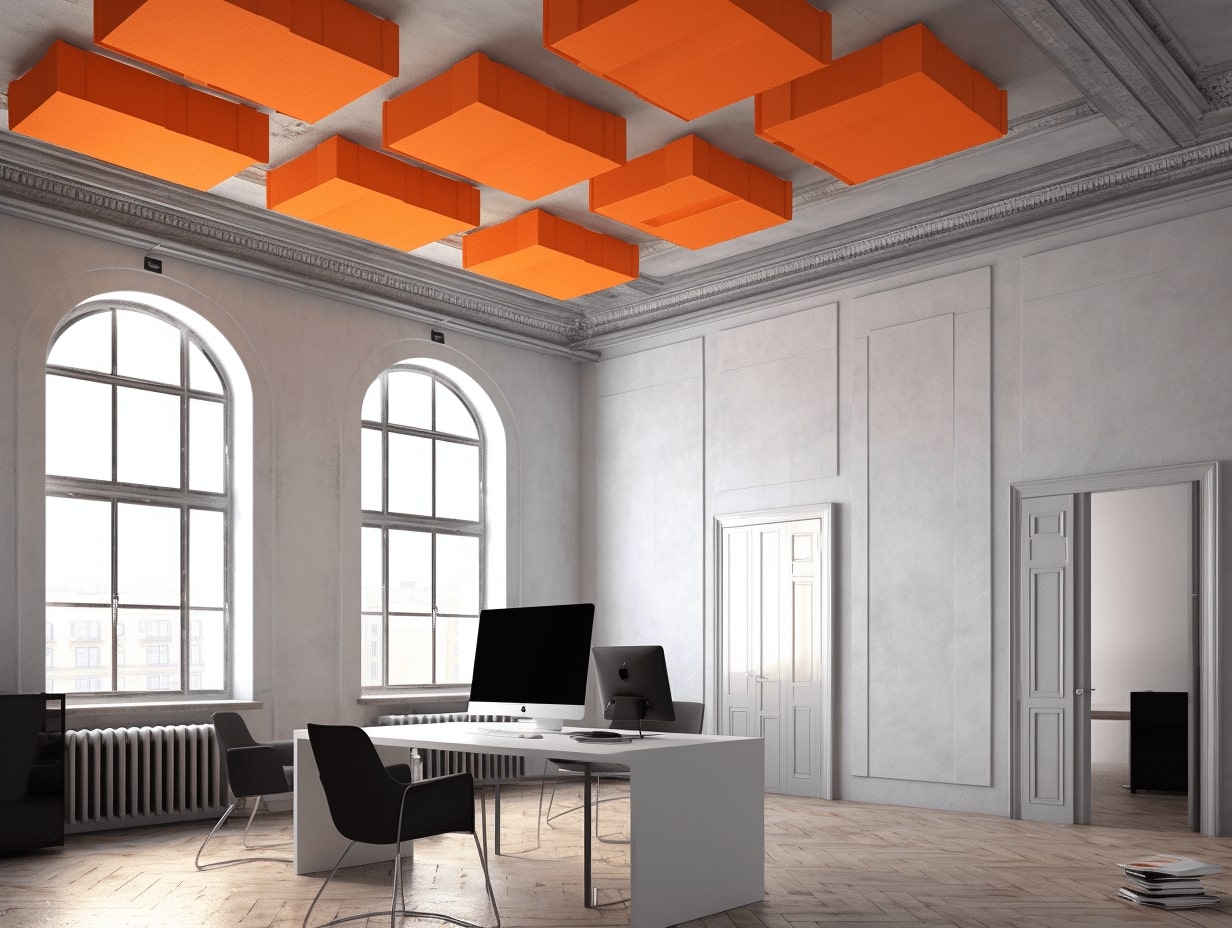
Innovations in Materials
Innovative materials play a crucial role in shaping the future of building acoustics. Designers increasingly utilize sound-absorbing materials like advanced acoustic panels made from recycled textiles, which provide effective noise reduction without compromising aesthetics. Additionally, bio-based materials, such as bamboo and cork, offer sustainable sound insulation solutions. These materials boast high density and texture, optimizing their acoustic properties in various environments. Incorporating transparent sound-absorbing materials allows for visual continuity while maintaining acoustic performance, transforming spaces into serene areas without sacrificing style.
Technology Integration
Integrating technology significantly influences building acoustics. Smart acoustic systems, equipped with sensors, detect sound levels and automatically adjust background noise to maintain optimal acoustic conditions. These systems utilize machine learning algorithms to analyze and adapt in real-time, enhancing speech intelligibility in offices and collaboration spaces. Moreover, virtual and augmented reality tools assist architects and designers in simulating acoustics during the planning stages, allowing us to visualize and manage sound behavior before construction. As we embrace these technologies, creating personalized acoustic environments in both residential and commercial spaces becomes more accessible and efficient.
Conclusion
Understanding building acoustics is essential for creating effective interior spaces that enhance comfort and productivity. By applying key acoustic principles such as sound absorption, sound insulation, and room acoustics, we can design environments that cater to users’ needs. Strategies like using mass-loaded barriers, installing acoustic panels, and incorporating soft furnishings help us reduce noise distractions and improve sound quality.
In both residential and commercial settings, effective acoustics significantly impact our quality of life and work efficiency. Soundproofing measures and strategic furnishings contribute to peaceful and focused environments. Future trends in building acoustics spotlight innovative materials and technologies that elevate user experiences. By embracing sustainable options and smart systems, we can further enhance our acoustic environments.
Together, these insights on building acoustics allow us to create spaces that foster tranquility and productivity.
- acoustic ceiling design
- acoustic consulting
- acoustic design for interiors
- acoustic optimization for interiors
- acoustic panels for interiors
- acoustic solutions for buildings
- Architectural acoustics
- building acoustics
- commercial space acoustics
- home theater acoustics
- indoor noise control
- interior acoustics
- noise reduction in buildings
- office acoustics
- residential acoustic design
- sound absorption techniques
- sound insulation for interiors
- soundproofing interior spaces
- soundproofing solutions
I create and manage digital content for architecture-focused platforms, specializing in blog writing, short-form video editing, visual content production, and social media coordination. With a strong background in project and team management, I bring structure and creativity to every stage of content production. My skills in marketing, visual design, and strategic planning enable me to deliver impactful, brand-aligned results.
Submit your architectural projects
Follow these steps for submission your project. Submission FormLatest Posts
The Ultimate Guide to Fencing in North Dakota: Choosing the Best Fence for Your Property
Watching a chain link fence twist in 70 mph winds near Minot...
Gaudí: Where Architecture Meets Science
Gaudí: Where Architecture Meets Science shows catenary arches, ruled surfaces, and biomimicry...
How Housing Market Forces Shape Architectural Design Today
Architecture never exists in isolation. Buildings rise from a mix of ambition,...
Why Portable Formaldehyde Gas Detectors Matter on Construction Sites
As construction practices shift toward more enclosed and material-intensive environments, the risk...












Leave a comment